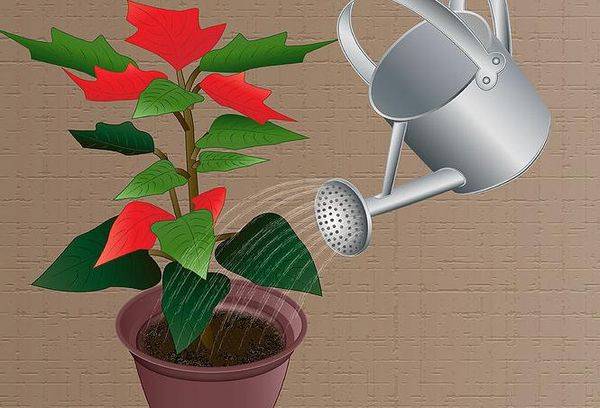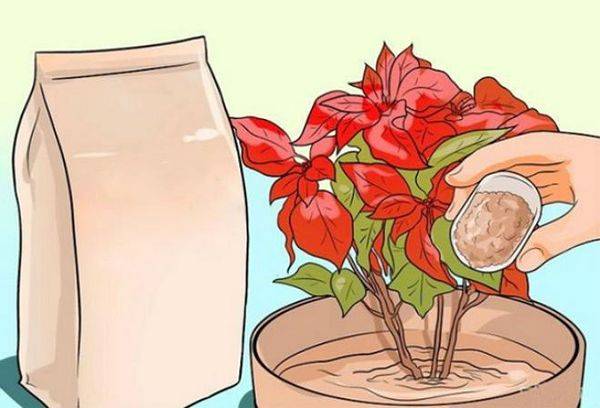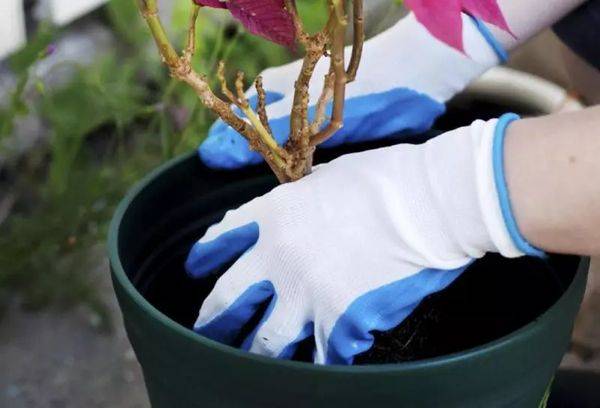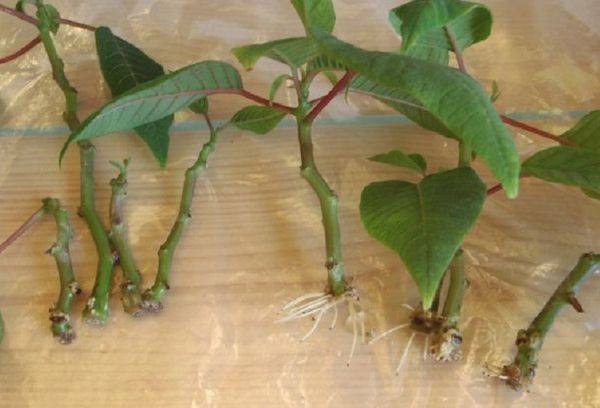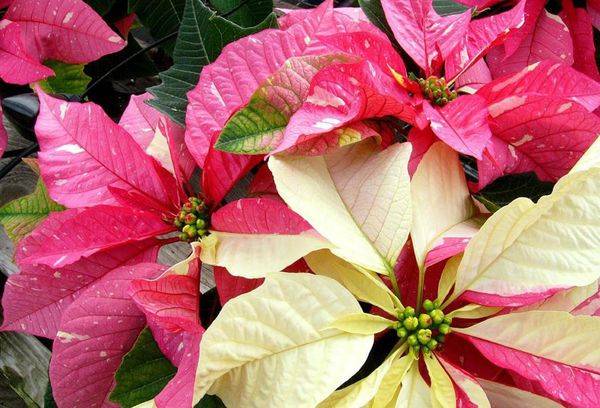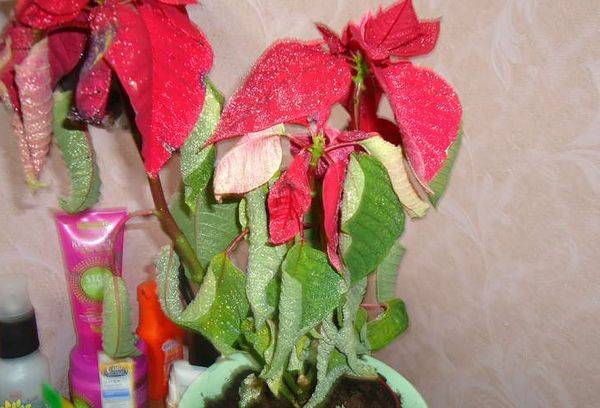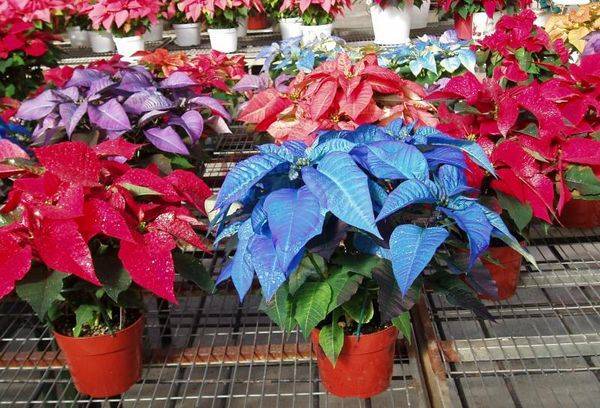How to grow poinsettia at home or (Star of Bethlehem)
Content:
“Christmas Star”, “Star of Bethlehem”, “Beautiful Euphorbia” - these are all the names of the beautiful poinsettia. The plant attracts florists by the fact that, with proper care, it blooms just before Christmas, creating a festive mood. The beauty of the flower does not leave you indifferent, and caring for it is quite simple. Even a beginner grower will cope with the cultivation of poinsettia and enjoy the treasured flowering. This article describes in detail the process of growing beautiful poinsettia at home: from watering and temperature to transplanting and preparing for flowering.
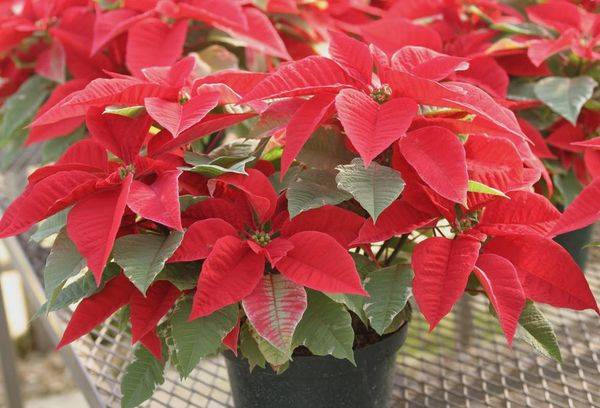
Annette Hegg Dark
Description
Poinsettia is beautiful (Poinsettia pulcherrima), or the most beautiful euphorbia (Euphorbia pulcherrima) is a plant of the genus Euphorbia from the family Euphorbia. Its homeland is Central America: Guatemala, Southern Mexico and Costa Rica. Wet, shady mountainsides are the natural habitat of a flower. This is the only species of its kind, but it has many varieties.
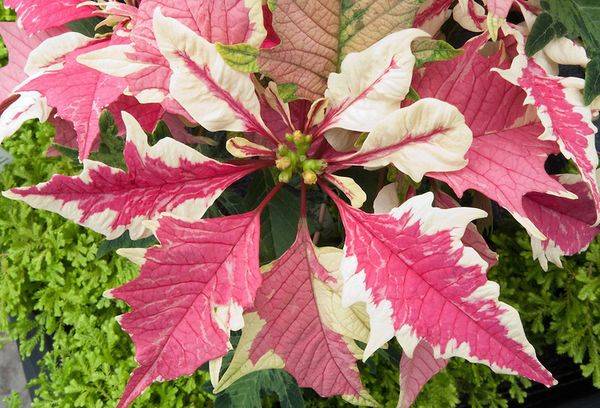
Strawberry and cream
The plant was first mentioned among the Aztecs who called it cuetlaxochitl. They made dye for fabric from red poinsettia bracts (red-violet), and white juice was used in folk medicine. Poinsettia owes its current name to the American botanist J. Poinsett, who discovered a beautiful flower in Mexico and selected the best samples for cultivation in its greenhouses.
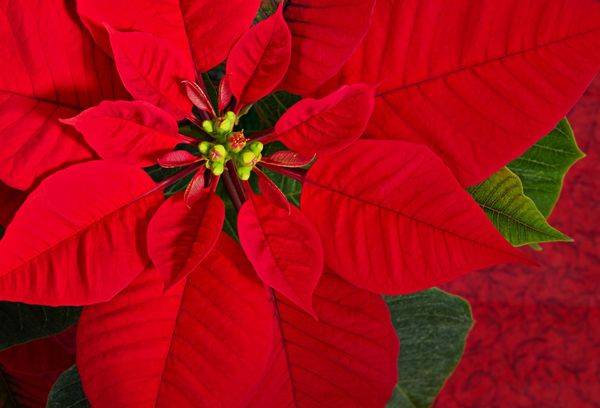
Poinsettia Tapestry
Euphorbia pulcherrima is an ornamental perennial shrub that reaches a height of 1.2-3, sometimes 4 m. Its branched stems are covered with oblong dark green leaves pointed to the edge. Beautiful poinsettia blooms with small yellow flowers collected in inflorescences-sockets. The beauty of blooming poinsettia is not concluded in inflorescences at all, but in bracts - leaves of bright shades: red, yellow, pink, others and their combinations. Thanks to bracts, poinsettia is valued as an ornamental plant.
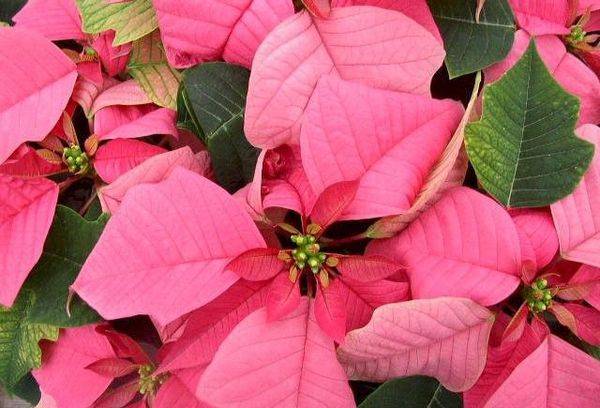
Poinsetia Carousel Pink
Varieties
The first variety, which was bred in the Poinsett greenhouse, was called "Oak Leaf" and had bright red bracts. Subsequently, breeders have achieved other sizes, shapes and colors of bracts, various combinations of colors, jewelry in the form of spots and stripes, greater resistance to disease. Here are the most popular varieties of poinsettia in home floriculture.
Cortez series dedicated to the Spanish conquistador Hernan Cortes:
- Cortez burgandy - a flower with green leaves and raspberry bracts, similar in shape. In the center is a golden inflorescence resembling an asterisk.
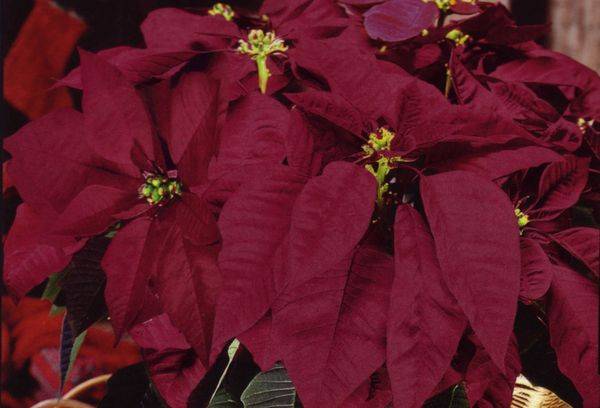
Cortez burgandy
- Cortez red - a variety with bright scarlet bracts decorated with dark green veins.
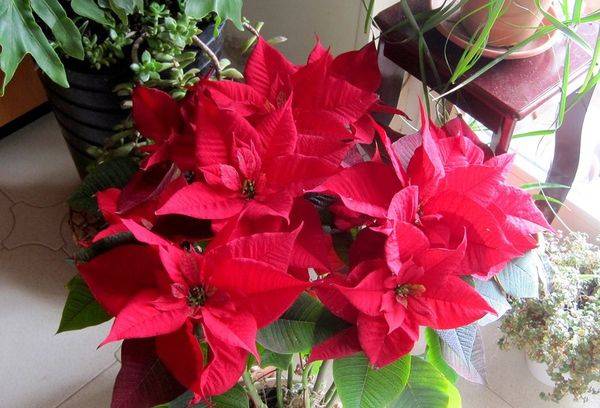
Cortez red
- Cortez pink - Achievement of breeders: pale pink bracts become lighter as they move away from the inflorescence.
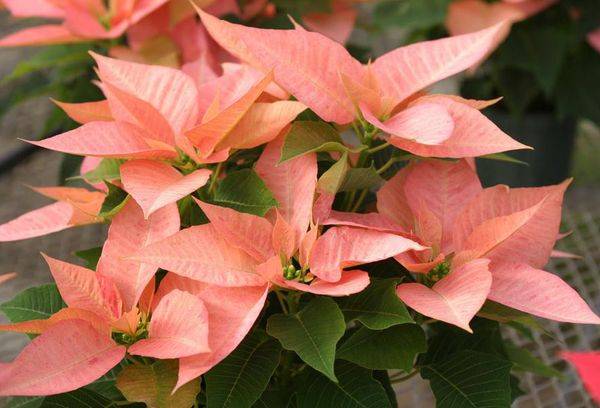
Cortez pink
Varieties with an unusual form of bracts:
- Winter rose - The first cultivated variety with terry leaves. Bracts of a shade of fuchsia with a green middle-inflorescence.
- Premium miro - harvested petals with a double color: noble white and pale pink.
- Winter rose early red - bright red bracts are collected at the very top of the plant and resemble roses.
- Winter rose white - gentle and warm milky cream shades.
- Freedom jingle bells - soft pink wavy bracts with a light green border.
- Carousel Red and Carousel Dark Red - poinsettias with fancifully sinuous edges of the bracts of pink and saturated red, respectively.
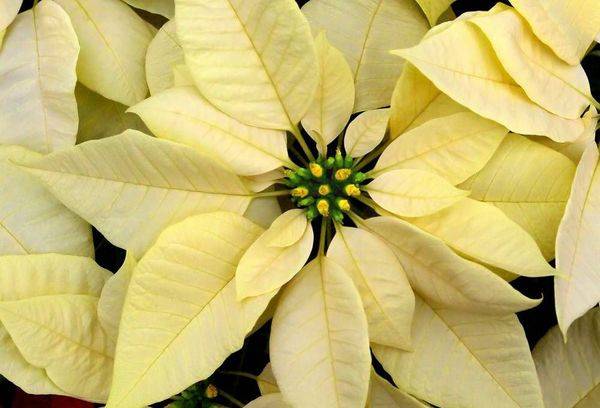
Poinsetia grade Cortez White
Other interesting varieties:
- Eckespoint lilo - variety with purple bracts.
- Da vinci - poinsettia with pale pink bracts resembling the frescoes of the great Leonardo.
- Sonora white - The owner of exquisite ivory leaves.
- Strawberry and cream - A variety that is interesting in both color and leaf shape. Bracts are colored in pink and purple, the edge of the bract is angular, as if indented.
- White star - the grade is fully consistent with the name. The white star goes well with the varieties of red poinsettia, forming an unforgettable Christmas composition.
- Polly pink - a flower with bright purple bracts.
- Polar bear - poinsettia with a clean range of bracts: white leaves with green veins.
- Prestige maroon - An aristocrat among euphorbiaceae. The noble purple color of the bracts is combined with dark, saturated green, ordinary leaves.
- Arctic White - a truly arctic shade of white.
- Monet twilight - white-pink bracts interspersed with red, as if someone had worked with a spray.
- Cinnamon star different in delicate shades of salmon pink.
- Lemon snow - the shade of the bracts is consistent with the name Lemon snow.
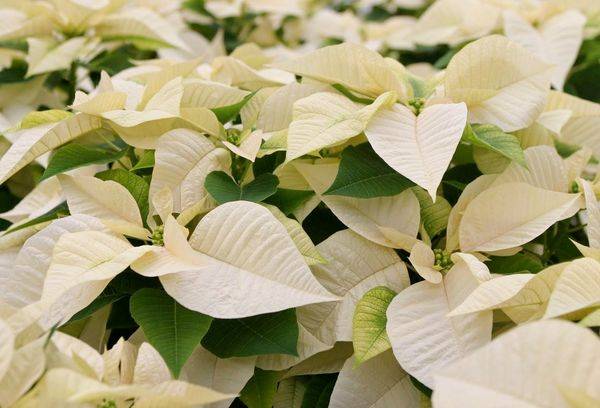
Sonora white
Varieties of poinsettia for a Christmas present:
- Premium ice crystals - The owner of the heart-shaped leaves around the inflorescence, resembling the color of rosy cheeks from frost.
- Jingle bells - carmine-red bracts of this variety are spotted, like fluffy snow flakes.
- Ice punch - leaves of a red tint, reminiscent of a New Year's drink punch.
- Sonora white glitter - the contrast of dark green leaves and red-white bracts creates a festive mood.
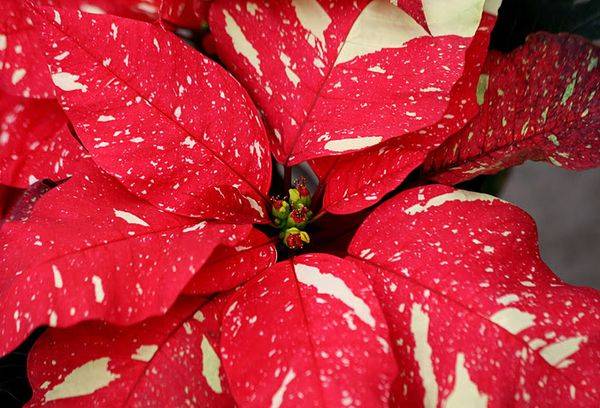
Sonora white glitter
Accommodation in the house
Have you acquired poinsettia but don’t know how to care for it? Start by choosing a planter and accommodation in an apartment. The flower pot must meet the following parameters: 2-2.5 times less than the plant in length and 2-2.5 times wider than the root system. It is important that the growing container is not too large. The larger the size of the pot, the slower the soil dries in it, and the excess of moisture in the soil of poinsettia is poorly tolerated.
Spurge the most beautiful loves bright, but diffused lighting. In the summer, a pot with poinsettia is better to put on window sills or balconies, only direct sunlight should not be allowed. Poinsettia located in the open air must be protected from rain, as the plant does not withstand excessive soil moisture. Drafts are also contraindicated in the flower, although it is necessary to ventilate the room where it grows regularly.
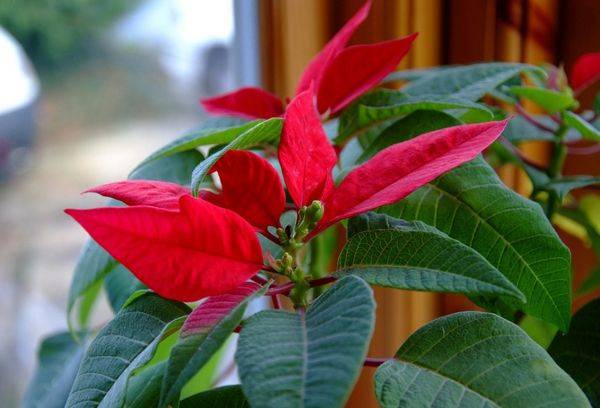
Cortez red
The plant likes warm, but not hot rooms. The air should not be too dry, otherwise poinsettia will drop the leaves. The optimum temperature for growing is not lower than + 16⁰ C and not higher than +24, that is, normal room conditions. In spring, it is recommended to lower the temperature slightly (to +18) so that the plant rests after a flowering period. Protect poinsettia from extreme temperatures.
Tip
Buy poinsettia with unopened buds in the winter, ensure its delivery home, carefully wrapped and protected from frost.
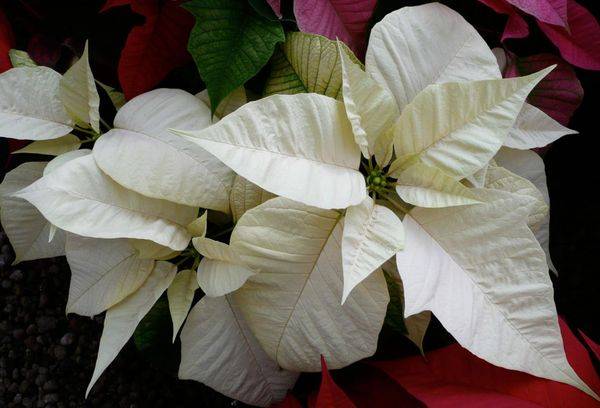
Sonora white
Poinsettia is grown in standard soil for euphorbiaceae. To independently make a substrate for a flower, you will need:
- sheet land - 2 parts;
- clay-turf land - 3 parts;
- peat - 1 part;
- sand - 1 part.
Organize good drainage. Expanded clay is suitable as a drainage layer. Put it on the bottom of the pot to a height of 3 cm.
Watering and humidity, top dressing
The beautiful poinsettia beautifully needs watering during the flowering period in the summer, when it actively builds up green mass. It is not necessary to water the flower daily, on the contrary, it can lead to decay of the roots. Each subsequent watering is carried out when the topsoil is dry. Water for irrigation is necessarily warm, preferably settled. During dormancy, watering is reduced to moderate. It is enough to prevent the soil from drying out.
Poinsettia is demanding on air humidity. In a too dry room, it often discards leaves and refuses to bloom. purityis.decorexpro.com/en/ magazine strongly recommends spraying poinsettia leaves with warm water, especially in winter, when the apartment is warm and dry due to the operation of heating systems. There is another danger in the lack of moisture. Dry air is an excellent environment for the existence of a pest - a spider mite.
Nutrition is divided into two periods:
- In spring and summer, when the plant is actively developing, it needs a complete mineral fertilizer.
- In autumn and until the end of the flowering period, the most beautiful euphorbia needs potassium-phosphorus additives.
Fertilization - once every two weeks. Organic fertilizers for flowering plants are suitable.
Bush formation, transplant
Poinsettia must be cut off before the dormant period, so that it can bloom again. This is the first stage in the formation of the bush. The second is pruning after the flower leaves the "hibernation". Choose 4-5 strong shoots, cut the rest with a sharp knife. The result should be a smooth and beautiful, but not thickened crown.
Poinsettia transplantation is carried out in April-May, after flowering and rest. A sign that the plant is ready for relocation is the appearance of young green leaves. At the same time, a new capacity is selected slightly more than the previous one and fresh soil for milkweed is used.
Transplant Technology:
- Put a drainage layer on the bottom of the pot.
- The transplantation takes place by the method of transshipment: the plant moves into a new pot with an old lump of earth on the roots. This measure helps poinsettia avoid stress and adapt more quickly to new conditions.
- To be sure, examine the roots, remove the decaying and drying parts of the root system, and then treat it with Kornevin.
- Fill the poinsettia roots with earth and place the pot in a warm place (approximately + 20⁰ C).
- Transplanted plants need active watering and spraying, as well as access to fresh air.
- After a few weeks, the flower fully survives in a new pot.
Breeding
Beautiful euphorbia propagates both by seeds and by cuttings. The first method is characteristic of the natural habitat. Cuttings are more suitable for propagating a flower at home.
How is the vegetative method of propagation carried out:
- In an adult plant, find a young shoot.
- Cut its top by 7 cm. It is desirable that the number of kidneys on the pruning is 6-7 pieces.
- Hold the resulting stalk for several minutes in warm water, then immerse in the rooting solution.
- Disinfect the cut with activated carbon.
- Plant the treated stalk into the moistened soil no deeper than 1 cm, otherwise it will not take root.
Bred by breeding varieties lose their characteristics when propagated by seeds. In addition, this material is difficult to obtain with the artificial cultivation of poinsettia. In the best case, a wild specimen of increased danger will break through.
Important
Poinsettias propagated by seed method are more toxic.
Bloom preparation
The cherished goal is the blooming of poinsettia for Christmas. How to achieve the desired? To poinsettia bloomed at home, it must be prepared in advance:
- First of all, poinsettia should have a good rest. Therefore, after flowering, they prune it, put it in a cool dark place and reduce watering. The period of "hibernation" lasts 2 months. Then the plant is removed from dormancy by transplanting, resuming normal watering and lighting. Until the beginning of autumn, the usual care rules apply.
- Starting in September, poinsettia must be prepared for flowering. To plant flower buds, a plant needs a short daylight hours. Therefore, 14 hours a day, poinsettia should be in a dark place, for example, in a closet. This period lasts two months. During preparation, watering is reduced so that the topsoil has time to dry.
- Two months later, if you did everything right, bracts begin to appear. The preparation is over.Take care of the plant according to the basic rules and expect bright flowering by Christmas.
After a flowering period, a new cycle begins. Before going into sleep mode, poinsettia drops its leaves. This is not a reason to treat the plant. You just need to cut a few shoots and move the pot to a cool place until young foliage appears in the spring.
Diseases and pests, growing problems
Poinsettia beautiful can suffer from pests:
- A spider mite attacks the plant when the air in the room is too dry. A sign of the parasite is yellow spots along the edge of the leaf and cobweb. The problem is solved with drugs - insecticides.
- Whitefly is a small mole that settles on the back of the leaf. If detected, rinse the flower with running water and treat it with an insecticide.
- A sign of the appearance of a mealybug - the leaves are covered with dew. Treat the leaves with a sponge dampened in soap or alcohol.
Growing problems:
- Leaves wither and fall - the plant does not have enough light. Other causes: excess or lack of moisture, drafts.
- The edges of the leaf plate turn yellow - a sign of lack of moisture.
- Yellowing of the leaf appears due to a spider mite.
- An equally common cause of sudden falling of foliage is a sharp change in temperature or lack of heat.
It is interesting
Interesting facts about the flower, as well as growing tips and precautions:
- Among the Aztecs, poinsettia was considered a symbol of purity and was even chosen by Montezuma (the Aztec emperor) as a royal flower.
- Poinsettia juice is toxic, can cause severe irritation to the skin and mucous membranes. Therefore, all work with the flower is carried out in protective gloves. After completion, be sure to wash your hands with soap.
- The flower is dangerous for pets who like to nibble everything that grows.
- Poinsettia with unopened buds is chosen as a gift. Such a plant will soon bloom and will delight the recipient for a long time.
- The name "Christmas Star" was assigned a flower in Europe, and more precisely, in England in the 19th century.
- Poinsettia sales before the New Year and Christmas almost triple.
- In America, December 12 is the national day of poinsettia.
A few tips on how to choose poinsettia in a store:
- Flowers should not have pollen. The color of the inflorescence is greenish or reddish. This poinsettia has not yet entered the active phase of flowering, so you will enjoy its decorative bracts longer.
- Bracts should have a pronounced color. Green spots are a sign of an unhealthy plant.
- The flower should be evenly covered with leaves, without exposed areas.
- A sign of diseased leaves is torsion and yellowness. Refuse such a purchase.
- Pay attention to the soil in the pot: because the substrate is too wet or too dry, the plant will be weakened.
- Do not buy a flower in the cold season on the street.
- In good stores, poinsettia pots are placed at a distance (the plant does not like crowding) and are sold without packaging.
Poinsettia beautiful is one of the most interesting representatives of euphorbiaceae. The flower lends itself well to selection, which allowed to bring out a wide variety of shapes and colors. The blossoming "Christmas Star" in the house creates an incredible atmosphere of comfort, celebration and happiness. Such a flower is often recommended to grow to maintain harmonious relationships in the family.
